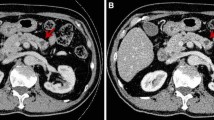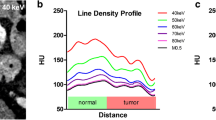Abstract
Objective
Perform multireader analysis of objective and subjective lesion conspicuity for small pancreatic adenocarcinomas using rapid switching dual energy CT (rsDECT).
Materials and methods
With IRB approval, 51 abdominal multiphasic rsDECT scans in 46 subjects with small (<3 cm) pancreatic adenocarcinomas were retrospectively reviewed by three independent readers for objective and subjective lesion conspicuity. Measured variables during individual, blinded interpretive sessions of separate low (52) keV, PACS-equivalent (70) keV, and iodine material density (MD) image sets included Hounsfield units (HU) and mg/cc iodine for tumor, nontumoral pancreas, and subcutaneous fat. Objective measures included absolute lesion contrast (LC) and contrast to noise ratios (CNR). Subjective measures included image quality, lesion conspicuity, and reader confidence. Reader agreement was measured with kappa statistic; correlation with truth by Pearson coefficient, CNR with repeated mANOVA; subjective quality measures utilized Tukey–Cramer corrections for multiple testing, p < 0.05 considered significant.
Results
Demographics: 26 F, 20 M, mean age 68 years, weight 75 kg, tumor size of 2.3 cm. LC was highest on 52 keV images for all three readers (mean 90.1 HU). Mean CNR for iodine MD images (4.87) was significantly higher than 52 keV (4.13) or 70 keV (3.9). Very high to near-perfect kappa values were observed for all individual measured objective variables but were best for 52 keV images (52 keV 0.89–0.95, 70 keV 0.76–0.83, iodine 0.87–0.92). 70 keV images scored best for subjective image quality; iodine MD images scored best for lesion conspicuity and reader confidence.
Conclusion
We observed very high reader agreement for independent objective rsDECT image variables and subjective rsDECT image scores in patients with small pancreatic adenocarcinomas. Maximal objective tumor to nontumoral LC was depicted on 52 keV and highest CNR on iodine MD images; readers scored the iodine MD images best for lesion conspicuity and confidence.





Similar content being viewed by others
References
American Cancer Society (2013) Cancer facts and figures 2013. Atlanta: American Cancer Society
Howlader N, Noone AM, Krapcho M, Garshell J, Neyman N, Altekruse SF, Kosary CL, Yu M, Ruhl J, Tatalovich Z, Cho H, Mariotto A, Lewis DR, Chen HS, Feuer EJ, Cronin KA (eds). SEER cancer statistics review, 1975–2010, National Cancer Institute. Bethesda, MD. http://seer.cancer.gov/csr/1975_2010/, based on November 2012 SEER data submission, posted to the SEER web site, April 2013. Surveillance, Epidemiology, and End Results Program. Accessed 9 June 2013
Callery MP, Chang KJ, Fishman EK, et al. (2009) Pretreatment assessment of resectable and borderline resectable pancreatic cancer: expert consensus statement. Ann Surg Oncol 16:1727–1733
Tamm EP, Silverman PM, Charnsangavej C, et al. (2003) Diagnosis, staging, and surveillance of pancreatic cancer. AJR 180(5):1311–1323
Rahib L, Smith BD, Aizenberg R, et al. (2014) Projecting cancer incidence and deaths to 2030: the unexpected burden of thyroid, liver, and pancreas cancers in the United States. Cancer Res 74(11):2913–2921
Marin D, Boll DT, Mileto A, Nelson RC (2014) State of the art: dual-energy CT of the abdomen. Radiology 271(2):327–342
Lu DS, Vedantham S, Krasny RM, et al. (1996) Two-phase helical CT for pancreatic tumors: pancreatic versus hepatic phase enhancement of tumor, pancreas, and vascular structures. Radiology 199:697–701
Fletcher JG, Wiersema MJ, Farrell MA, et al. (2003) Pancreatic malignancy: value of arterial, pancreatic, and hepatic phase imaging with multi-detector row CT. Radiology 229(1):81–90
Bronstein YL, Loyer EM, Kaur H, et al. (2004) Detection of small pancreatic tumors with multiphasic helical CT. AJR 182(3):619–623
Prokesch RW, Chow LC, Beaulieu CF, Bammer R, Jeffrey RB Jr (2002) Isoattenuating pancreatic adenocarcinoma at multi-detector row CT: secondary signs. Radiology 224:764–768
Wong JC, Raman S (2010) Surgical resectability of pancreatic adenocarcinoma: CTA. Abdom Imaging 35(4):471–480
Kim JH, Park SH, Yu ES, et al. (2010) Visually isoattenuating pancreatic adenocarcinoma at dynamic-enhanced CT: frequency, clinical and pathologic characteristics, and diagnosis at imaging examinations. Radiology 257:87–96
Yoon SH, Lee JM, Cho JY, et al. (2011) Small (20 mm) pancreatic adenocarcinomas: analysis of enhancement patterns and secondary signs with multiphasic multidetector CT. Radiology 259:442–452
Gangi S, Fletcher JG, Nathan MA, et al. (2004) Time interval between abnormalities seen on CT and the clinical diagnosis of pancreatic cancer: retrospective review of CT scans obtained before diagnosis. AJR Am J Roentgenol 182:897–903
Patel BN, Thomas JV, Lockhart ME, Berland LL, Morgan DE (2013) Single-source dual-energy spectral multidetector CT of pancreatic adenocarcinoma: optimization of energy level viewing significantly increases lesion contrast. Clin Radiol 68(2):148–154
Macari M, Spieler B, Kim D, et al. (2010) Dual-source dual-energy MDCT of pancreatic adenocarcinoma: initial observations with data generated at 80 kVp and simulated weighted-average 120 kVp. AJR 194:W27–W32
Marin D, Nelson RC, Barnhart H, et al. (2010) Detection of pancreatic tumors, image quality, and radiation dose during the pancreatic parenchymal phase: effect of low-tube-voltage, high-tube-currect CT technique—preliminary results. Radiology 256:450–459
Holm J, Louizou L, Albiin N, et al. (2012) Low tube voltage CT for improved detection of pancreatic cancer: detection threshold for small, simulated lesions. BMC Med Imaging 12:20
Lin XZ, Wu ZY, Tao R, et al. (2012) Dual energy spectral CT imaging of insulinoma-value in preoperative diagnosis compared with conventional multi-detector CT. Eur J Radiol 81:2487–2494
Klauss M, Stiller W, Pahn G, et al. (2013) Dual-energy perfusion-CT of pancreatic adenocarcinoma. Eur J Radiol 82:208–214
Zhao L, He W, Li J, et al. (2012) Improving image quality in portal venography with spectral CT imaging. Eur J Radiol 81:1677–1681
Brook OR, Gourtsoyianni S, Brook A, et al. (2013) Split-bolus spectral multidetector CT of the pancreas: assessment of radiation dose and tumor conspicuity. Radiology 269:139–148
Kim H, Arnoletti JP, Christein J, et al. (2014) Pancreatic adenocarcinoma: a pilot study of quantitative perfusion and diffusion weighted breath-hold magnetic resonance imaging. Abdom Imaging 39(4):744–752
Sarver DB, Yester M, Berland LL, Bolus DM, Fineberg NS, Morgan DE (2012) Radiation exposure during single source dual energy spectral MDCT for multiphasic abdominal exams: it’s not what you think. Abstract presented at the scientific session of the Society of Gastrointestinal Radiology, Scottsdale, AZ, March 25, 2012
Author information
Authors and Affiliations
Corresponding author
Rights and permissions
About this article
Cite this article
McNamara, M.M., Little, M.D., Alexander, L.F. et al. Multireader evaluation of lesion conspicuity in small pancreatic adenocarcinomas: complimentary value of iodine material density and low keV simulated monoenergetic images using multiphasic rapid kVp-switching dual energy CT. Abdom Imaging 40, 1230–1240 (2015). https://doi.org/10.1007/s00261-014-0274-y
Published:
Issue Date:
DOI: https://doi.org/10.1007/s00261-014-0274-y




